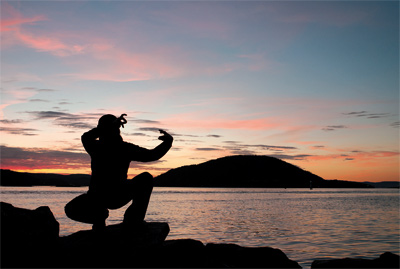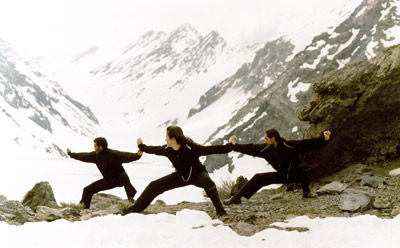Amidst the realities of work and family, we search for time for ourselves, for moments of quiet relaxation, for the perfect intersection of vitality and inner harmony. So how can we build our inner life amidst the constant buzz of the city? Boabom could be the answer.
An introduction to Boabom
Boabom is the art of active relaxation and meditation in movement. It comprises of various systems ranging from gentle movements, through active and stationary meditations, to a unique form of defence that eschews contact and competition. It creates instead a ‘non-defence’ system reaching beyond just the physical sense into the emotional and psychological realms as well. Boabom’s roots are in pre-Buddhist Tibet, but today its practice is growing around the world. Many people find its perspective a refreshing change and its exercises a profound way to develop all aspects of health. With its focus on positive energy and gradual progression, Boabom in any or all of its forms, helps to achieve those elusive twin goals of inner tranquillity and resilient vitality.
Seamm-Jasani: The perfection of quietude
 Seamm-Jasani is the first major branch of the Boabom Arts. It consists of simple warm-up exercises and gentle, fluid movements, all bound closely with the fundamental force of life—the breath. These movements work with the whole body, allowing the body to be strong yet flexible. The deep breathing techniques used throughout Seamm-Jasani cleanse the body whilst channeling a strong internal energy. A class begins with a gentle warm-up designed to awaken the whole body, to stretch and work every muscle from the toes to the eyes. When this cycle is complete, more coordinative movements begin, starting with simple arm movements.
Seamm-Jasani is the first major branch of the Boabom Arts. It consists of simple warm-up exercises and gentle, fluid movements, all bound closely with the fundamental force of life—the breath. These movements work with the whole body, allowing the body to be strong yet flexible. The deep breathing techniques used throughout Seamm-Jasani cleanse the body whilst channeling a strong internal energy. A class begins with a gentle warm-up designed to awaken the whole body, to stretch and work every muscle from the toes to the eyes. When this cycle is complete, more coordinative movements begin, starting with simple arm movements.
As you go through a Seamm-Jasani class, the rhythm of this breath forms the basis for the melody of the movements. This produces a deep inner relaxation and attunes our mind to positive thoughts. With its harmonious movements that reflect joy and comfort, Seamm-Jasani helps guide us towards joviality, increasing our positive energies. All of this predisposes us to face our daily lives constructively and with optimism. Because of this, Seamm-Jasani is also known as the ‘Art of Eternal Youth’.
“Self-defense is Nature’s eldest law.”
–John Dryden, British poet and dramatist
Osseous Boabom: The art of defense and energy
 Osseous Boabom is the second principal branch of the Boabom Arts. It brings speed, energy and elements of defence to the same structure of exercise as a Seamm-Jasani class. The warm-ups are quicker and more intense, followed by movements and co-ordinations that can function as practical and effective defence. Yet in Boabom there is never any contact or competition; this is in fact one of its fundamental tenets and one of the many differences between Boabom and martial arts. As students learn, they gradually build a web of movements, one piece at a time, focussing on producing the maximum energy in combination with a precise technique.
Osseous Boabom is the second principal branch of the Boabom Arts. It brings speed, energy and elements of defence to the same structure of exercise as a Seamm-Jasani class. The warm-ups are quicker and more intense, followed by movements and co-ordinations that can function as practical and effective defence. Yet in Boabom there is never any contact or competition; this is in fact one of its fundamental tenets and one of the many differences between Boabom and martial arts. As students learn, they gradually build a web of movements, one piece at a time, focussing on producing the maximum energy in combination with a precise technique.
In most martial arts, the expectation of being hit or having to hit, creates stress. No matter how much practice goes in, it is a thought that can run very deep, creating a hidden tension that reveals itself in a moment of stress. With Osseous Boabom, you can express your strength without the fear of aggression or the perceived danger of contact. This way you are able to maintain a clear and open mind in any moment of danger. This enables you not only to find a non-violent solution out of a threatening situation, but also to be clear and quiet in the face of stress. Thus we see that the word ‘defence’ means much more than something physical; rather, defence becomes a manifestation of resilience, of confidence and security that we can carry with us every day.
Meditation and movement in practice
In both, Seamm-Jasani and Osseous Boabom, as well as other branches of the Boabom Arts, one of the principal goals is to use the body to move the mind.
A simple breathing exercise, done a few times daily, can yield excellent results. A Seamm-Jasani or Osseous Boabom class practiced once a week helps to develop the body and mind in unison and to improve the overall state of health. You do not need to be of a certain age or physical condition, for while the practice of Osseous Boabom requires a basic level of physical fitness, Seamm-Jasani can be practiced by anyone, of any age, so long as students work within their measure, advancing slowly over time. At a Boabom school you will find students from the ages of five to 85, breathing, stretching, and working in a way that is right for them, under the guidance of an experienced teacher.
If there is no school nearby, you can learn from one of several books; there are instructional guides that provide a progressive class of several months’ duration. You can also learn the basic Seamm-Jasani breathing technique on YouTube.
Seamm-Jasani: Breathing technique
 The Great Circle
The Great Circle
Step 1: Stand with your back straight and your hands placed in front of your thighs, the palms facing in front. Place your tongue against the roof of your mouth and start to inhale through the nose. Make the nasal sound ‘nnnsss…’ while inhaling.
Step 2: Inhale and at the same time raise your arms, forming a circle going up. Your hands will finish flat and above your head, your fingertips touching each other and you stop inhaling. In this position, try to contain the air for about five seconds.
 Stage 3: Lower your tongue down from your palate and exhale through your mouth, rounding your lips and forcing the air along the throat with a gentle pressure, making an “hhhaaa…” sound. The natural pressure of this phase is exerted in the throat, and with this we clean out any dust that settles in our breathing tract. The rounding of the lips also helps to create the sound of this exhalation, in between the long ‘a’ and ‘o’ sounds, and this too must be audible from at least five or six feet away. If it is inaudible, it will not result in the benefits that we seek.
Stage 3: Lower your tongue down from your palate and exhale through your mouth, rounding your lips and forcing the air along the throat with a gentle pressure, making an “hhhaaa…” sound. The natural pressure of this phase is exerted in the throat, and with this we clean out any dust that settles in our breathing tract. The rounding of the lips also helps to create the sound of this exhalation, in between the long ‘a’ and ‘o’ sounds, and this too must be audible from at least five or six feet away. If it is inaudible, it will not result in the benefits that we seek.
This technique must be repeated two or three times. It serves as an excellent form of relaxation, and a good way to release tension and stress in negative situations. Remember this breathing technique, as it will help you clear your mind, calm down and escape a nervous mental state.
- Photographers: Asanaro and Yemado
 Spot an error in this article? A typo maybe? Or an incorrect source? Let us know!
Spot an error in this article? A typo maybe? Or an incorrect source? Let us know!
